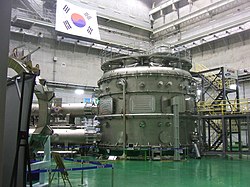KSTAR
| Korea Superconducting Tokamak Advanced Research | |
|---|---|
 | |
| Device type | Tokamak |
| Location | Daejeon, South Korea |
| Affiliation | National Fusion Research Institute |
| Technical specifications | |
| Major radius | 1.8 m (5 ft 11 in) |
| Minor radius | 0.5 m (1 ft 8 in) |
| Magnetic field | 3.5 T (35,000 G) |
| Heating power | 14 MW |
| Plasma current | 2 MA |
| History | |
| Date(s) of construction | 14 September 2007 |
| Year(s) of operation | 2008–present |
The KSTAR (or Korea Superconducting Tokamak Advanced Research; Template:Lang-ko, literally "superconducting nuclear fusion research device")[1] is a magnetic fusion device at the National Fusion Research Institute in Daejeon, South Korea. It is intended to study aspects of magnetic fusion energy which will be pertinent to the ITER fusion project as part of that country's contribution to the ITER effort. The project was approved in 1995 but construction was delayed by the East Asian financial crisis which weakened the South Korean economy considerably; however the construction phase of the project was completed on September 14, 2007. The first plasma was achieved in June 2008.[2][3]
Description
KSTAR is one of the first research tokamaks in the world to feature fully superconducting magnets, which again will be of great relevance to ITER as this will also use superconducting magnets. The KSTAR magnet system consists of 16 niobium-tin direct current toroidal field magnets, 10 niobium-tin alternating current poloidal field magnets and 4 niobium-titanium alternating current poloidal field magnets. It is planned that the reactor will study plasma pulses of up to 20 seconds duration until 2011, when it will be upgraded to study pulses of up to 300 seconds duration. The reactor vessel will have a major radius of 1.8 m, a minor radius of 0.5 m, a maximum toroidal field of 3.5 Tesla, and a maximum plasma current of 2 megaampere. As with other tokamaks, heating and current drive will be initiated using neutral beam injection, ion cyclotron resonance heating (ICRH), radio frequency heating and electron cyclotron resonance heating (ECRH). Initial heating power will be 8 megawatt from neutral beam injection upgradeable to 24 MW, 6 MW from ICRH upgradeable to 12 MW, and at present undetermined heating power from ECRH and RF heating. The experiment will use both hydrogen and deuterium fuels but not the deuterium-tritium mix which will be studied in ITER.
In December 2016, KSTAR set a world record (longest high-confinement mode) by confining and maintaining a high-temperature hydrogen plasma (about 50 million degrees Celsius) for 70 seconds.[4][5] The record was broken by China's Experimental Advanced Superconducting Tokamak (EAST) (101.2 seconds) in July 2017.[6]
Timeline
This section needs additional citations for verification. (March 2020) |
The design was based on Tokamak Physics Experiment which was based on Compact Ignition Tokamak design - See Robert J. Goldston.
- 1995 - Started Project KSTAR
- 1997 - JET of EU emits 17 MW energy from itself.
- 1998 - JT-60U went beyond energy junction successfully, and acknowledged possibility of commercialization of nuclear fusion.
- 2006 - Life span of 3 Fusion Reactors (JT-60U, JET, and DIII-D) are terminated.
- 2007, September - KSTAR's major devices are constructed.
- 2008, July - First plasma occurred. Maintenance time: 0.865 seconds, Temperature: 2×106 K
- 2009 - Maintained 320,000A plasma for 3.6 seconds.
- 2010, November - First H-mode plasma run.[7]
- 2011 - Maintained high-temperature plasma for 5.2 seconds, Temperature: ~50×106 K, successfully fully deterred ELM (Edge-Localized Mode), first ever in the World.
- 2012 - Maintained high-temperature plasma for 17 seconds, Temperature: 50×106 K
- 2013 - Maintained high-temperature plasma for 20 seconds, Temperature: 50×106 K
- 2014 - Maintained high-temperature plasma for 45 seconds, and successfully fully deterred ELM for 5 seconds.
- 2015 - Maintained high-temperature plasma for 55 seconds, Temperature: 50×106 K
- 2016 - Maintained high-temperature plasma for 70 seconds, Temperature: 50×106 K, and successfully made ITB-mode for 7 secs.[8]
- 2017 - Maintained high-temperature plasma for 72 seconds, Temperature: 70×106 K, and successfully fully deterred ELM for 34 seconds, with using 9.5 MW heating system.
- 2019 - Maintained high-temperature plasma for 1.5 seconds, Temperature: >100×106 K.
- 2020, March - Maintained high-temperature plasma for 8 seconds, Temperature: >100×106 K (Mean temperature: >97×106 K)[9]
- 2020, Nov - Maintained high-temperature plasma for 20 seconds, Temperature: >100×106 K.[10]
References
- ^ "KSTAR | 국가핵융합연구소". www.nfri.re.kr (in Korean). Retrieved 2020-06-20.
- ^ "www.knfp.net". October 23, 2015. Archived from the original on 2015-10-23.
- ^ "KSTAR celebrates first plasma". ITER. Retrieved 2018-09-18.
- ^ "Korean fusion reactor achieves record plasma - World Nuclear News". www.world-nuclear-news.org. 14 Dec 2016. Retrieved 2018-09-18.
- ^ Andrews, Robin (19 Dec 2016). "South Korea Just Set A Nuclear Fusion World Record". IFLScience. Retrieved 2018-09-18.
- ^ Chinese Academy of Sciences (6 Jul 2017). "China's 'artificial sun' sets world record with 100 second steady-state high performance plasma". Retrieved 2018-09-18.
- ^ First H-mode plasma achieved on KSTAR
- ^ [1] Archived 2017-04-16 at the Wayback Machine NFRI News 14, December 2016
- ^ "한국형 인공태양, 섭씨 1억도 플라스마 8초 운전 성공 – Sciencetimes" (in Korean). Retrieved 2020-11-28.
- ^ "Korean artificial sun sets the new world record of 20-sec-long operation at 100 million degrees". phys.org. Retrieved 2020-12-29.
External links
- KSTAR homepage
- English KSTAR homepage
- KSTAR Project Status PDF (undated - seems to be 2001. Includes slide-13 construction schedule to end 2004 and slide-16 operation from 2005 with upgrade planned 2010-11.)
- KSTAR Assembly Status, October 2006 PDF
- Status and Result of the KSTAR Upgrade for the 2010s Campaign
- KSTAR ICRF transmission line system upgrade for load resilient operation. Jan 2013
